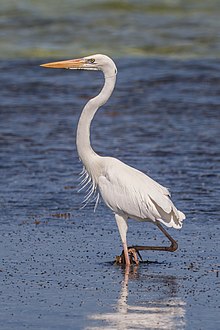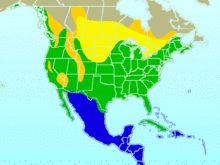
Back بلشون أزرق كبير Arabic بلشون ازرق كبير ARZ Ardea herodias AST Cakiw ATJ Голяма синя чапла Bulgarian বড় নীল বক Bengali/Bangla Kerc'heiz vras Amerika Breton Bernat americà Catalan Ardea herodias CEB Ne'potátse CHY
| Great blue heron Temporal range:
| |
|---|---|

| |
| In the Conestogo River, near St. Jacobs, Ontario | |

| |
| White form, possibly A. h. occidentalis, in Cayo Guillermo National Park, Cuba | |
| Scientific classification | |
| Domain: | Eukaryota |
| Kingdom: | Animalia |
| Phylum: | Chordata |
| Class: | Aves |
| Order: | Pelecaniformes |
| Family: | Ardeidae |
| Genus: | Ardea |
| Species: | A. herodias
|
| Binomial name | |
| Ardea herodias | |

| |
| North American range (also in far northwestern South America, not shown)
Breeding range Year-round range Wintering range Present during migration
| |
The great blue heron (Ardea herodias) is a large wading bird in the heron family Ardeidae, common near the shores of open water and in wetlands over most of North and Central America, as well as far northwestern South America, the Caribbean and the Galápagos Islands. It is occasionally found in the Azores and is a rare vagrant to Europe. An all-white population found in south Florida and the Florida Keys is known as the great white heron. Debate exists about whether these white birds are a color morph of the great blue heron, a subspecies of it, or an entirely separate species.[2][3]
- ^ BirdLife International (2020). "Ardea herodias". IUCN Red List of Threatened Species. 2020: e.T181500967A181565357. doi:10.2305/IUCN.UK.2020-3.RLTS.T181500967A181565357.en. Retrieved 11 November 2021.
- ^ "Great White Heron". fws.gov. U.S. Fish & Wildlife Service. Retrieved 6 September 2018.
- ^ Sibley, David Allen (5 November 2007). ""Great White" Heron – not just a color morph". Sibley Guides. Retrieved 6 September 2018.
